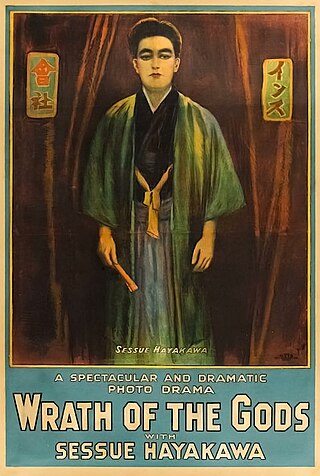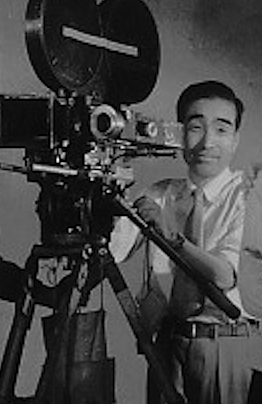
The cinema of Japan, also known domestically as hōga, has a history that spans more than 100 years. Japan has one of the oldest and largest film industries in the world; as of 2021, it was the fourth largest by number of feature films produced. In 2011, Japan produced 411 feature films that earned 54.9% of a box office total of US$2.338 billion. Films have been produced in Japan since 1897.

Kintarō Hayakawa, known professionally as Sessue Hayakawa, was a Japanese actor and a matinée idol. He was a popular star in Hollywood during the silent film era of the 1910s and early 1920s. Hayakawa was the first actor of Asian descent to achieve stardom as a leading man in the United States and Europe. His "broodingly handsome" good looks and typecasting as a sexually dominant villain made him a heartthrob among American women during a time of racial discrimination, and he became one of the first male sex symbols of Hollywood.

Three Came Home is a 1950 American World War II film directed by Jean Negulesco, based on the memoirs of the same name by writer Agnes Newton Keith. It depicts Keith's life in North Borneo in the period immediately before the Japanese invasion in 1942, and her subsequent internment and suffering, separated from her husband Harry, and with a young son to care for. Keith was initially interned at Berhala Island near Sandakan, North Borneo but spent most of her captivity at Batu Lintang camp at Kuching, Sarawak. The camp was liberated in September 1945.

The Dragon Painter is a 1919 English language silent romance drama film. It is based on the novel of the same name, written by Mary McNeil Fenollosa. It stars Sessue Hayakawa as a young painter who believes that his fiancée, is a princess who has been captured and turned into a dragon. It was directed by William Worthington and filmed in Yosemite Valley, Yosemite National Park, and in the Japanese Tea Garden in Coronado, California.
New French Extremity describes a range of French transgressive films made at the turn of the 21st century that sparked controversy, and provoked significant debate and discussion. were notable for including graphic images of violence, especially sexual violence and rape, as well as explicit sexual imagery.
The Morning Sun Shines is a 1929 Japanese film directed by Kenji Mizoguchi and Seiichi Ina. Intended as a promotional film for the newspaper Asahi Shimbun, it combines fictional and documentary elements. Only a fragment of the film survives today.

Souls on the Road is a 1921 Japanese silent film directed by Minoru Murata. Film critic Mark Cousins wrote that it was "the first landmark film in Japanese history". The film's plot is adapted from Maxim Gorky's play, The Lower Depths, and Wilhelm Schmidtbonn's drama, Children on the Street.

The Wrath of the Gods is a 1914 American silent drama film directed by Reginald Barker and starring Sessue Hayakawa, Tsuru Aoki, Frank Borzage, Thomas Kurihara and Henry Kotani. This was the first feature film appearance of Hayakawa and the directorial debut of Barker.

O Mimi San is a 1914 American short silent drama film directed by Charles Miller, featuring Tsuru Aoki in the title role and Sessue Hayakawa.

Sessue Hayakawa: Silent Cinema and Transnational Stardom is a biography of actor Sessue Hayakawa, written by Daisuke Miyao, assistant professor of film at the University of Oregon, and published by Duke University Press. It won the 2007 Book Award in History from the Association of Asian American Studies and the John Hope Franklin Book Award from Duke University (2007).

Ozu's Anti-Cinema is a 1998 book written by Yoshishige Yoshida, translated into English in 2003, and published by Center for Japanese Studies, University of Michigan. It included analysis and commentary on Yasujirō Ozu's films and film-making techniques.
Sen Yan's Devotion is a 1924 British drama film directed and written by A.E. Coleby. Sessue Hayakawa, Tsuru Aoki, Fred Raynham, Jeff Barlow and Tom Coventry featured in the film.
Hitler's Heroines: Stardom and Womanhood in Nazi Cinema is a 2003 book written by Antje Ascheid and published by Temple University Press.
Filming Women in the Third Reich is a 2000 book written by Jo Fox and Angela Gaffney.
Oxford Handbook of Japanese Cinema is a 2010 non-fiction book published by Oxford University Press and edited by Daisuke Miyao.
Daisuke Miyao is a professor of Japanese films at the University of Oregon and the University of California San Diego. He is also the author of Sessue Hayakawa: Silent Cinema and Transnational Stardom and The Aesthetics of Shadow: Lighting and Japanese Cinema, editor of Oxford Handbook of Japanese Cinema and co-translator of Ozu's Anti-Cinema.

I Graduated, But... is a 1929 Japanese silent film directed by Yasujirō Ozu. The film is now lost, except for an excerpt of approximately 10 minutes.
The Weavers of Nishijin, also known in English simply as Nishijin, is a 1961 Japanese short documentary film directed by Toshio Matsumoto. It starred Hideo Kanze as a Noh player. Film scholar Mitsuyo Wada-Marciano has written that the film's "depiction of a craftsmen's forced life in the traditional textile trade of Kyoto discloses the multiplicity of the Japanese as well as offering an instance to contemplate the role of cinema as the most popular culture at that time."

The Ghost Cat of Otama Pond is a 1960 Japanese horror film directed and co-written by Yoshihiro Ishikawa, in his directorial debut. Produced by Shintoho, it belongs to the subgenre of "ghost cat" films, featuring a cat-like supernatural entity.

Mitsuo Miura was a Japanese cinematographer who photographed more than 100 films in a career that spanned 30 years. He worked for film directors such as Shirō Toyoda, Heinosuke Gosho, Mikio Naruse, Shigeyoshi Suzuki, and Kajirō Yamamoto. An award for new cinematographers was named after him in his memory.












